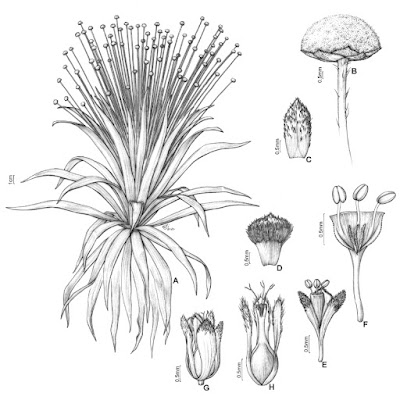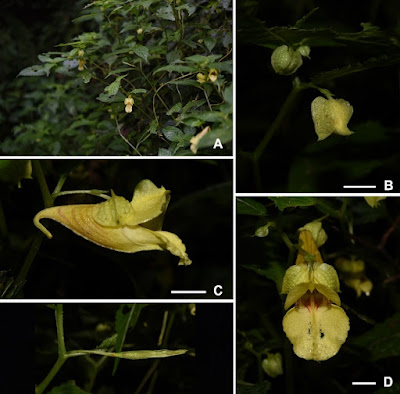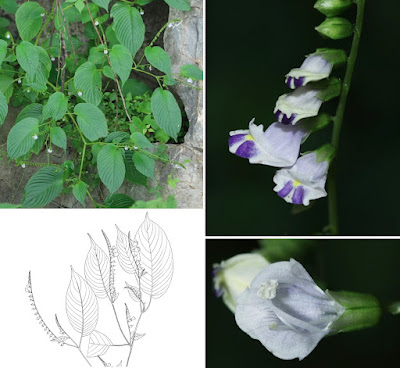[Most Recent Entries] [Calendar View]
Saturday, July 31st, 2021
| Time | Event | ||||
| 9:17a | [Botany • 2021] Paepalanthus mellosilvae (Eriocaulaceae) • A New Species from the Mantiqueira Range in Minas Gerais, Brazil Abstract Paepalanthus mellosilvae is here described and illustrated as a new species of Eriocaulaceae from the Atlantic Forest domain in Minas Gerais state, Brazil. The new species is known from a single locality in the Mantiqueira Range, growing along trails through cloud forests. According to the IUCN criteria, it is suggested here as critically endangered. Paepalanthus mellosilvae is compared to P. harmsii, a morphologically similar species also growing in the Mantiqueira Range, being mainly distinguished by the presence of a rhizome, narrower leaves, more numerous scapes, narrower capitula, sparsely pilose involucral bracts, and obdeltate floral bracts. Additional comments on the taxonomy, morphology, and distribution of the species, along with illustrations are provided. The specific epithet is a tribute to Prof. Dr. Renato de Mello-Silva. Keywords: Atlantic Forest, Endemism, Poales, Taxonomy, Tribute, Monocots Paepalanthus mellosilvae Trovó, sp. nov. Etymology:— The epithet “mellosilvae” is a tribute to Prof. Dr. Renato de Mello-Silva, who collected a very complete set of specimens of this new species, which was selected as the type collection. Renato was a tenacious botanist, an inspiring professor, and a good friend. Marcelo Trovó. 2021. Paepalanthus mellosilvae (Eriocaulaceae), A New Species from the Mantiqueira Range in Minas Gerais, Brazil. Phytotaxa. 500(3); 248–252. DOI: 10.11646/phytotaxa.500.3.9 | ||||
| 2:51p | [Botany • 2021] Impatiens bullatisepala (Balsaminaceae) • A New Species from Guizhou, China
Abstract Impatiens bullatisepala (Balsaminaceae), a new species supported by morphological and phylogenetic evidence from Fanjing Mountain, Guizhou province in China, is described here. It is morphologically similar to I. davidii but can be distinguished by its dorsally ridged lateral sepals with sunk reticulate veins and bullate projections on abaxial surface, 2–2.5 cm deep saccate lower sepal with ca. 0.8 cm long narrowly triangular tip at the mouth, and broadly ovate dorsal petal. Phylogenetic analyses of a combined dataset of nuclear ITS and plastid atpB-rbcL intergenic spacer DNA sequences furtherly confirmed its novelty. Keywords: Impatiens davidii, new taxon, taxonomy, Balsaminaceae, Eudicots Impatiens bullatisepala G.W. Hu, Y.Y. Cong & Q.F. Wang sp. nov. Etymology:— The specific epithet “bullatisepala” refers to the lateral sepals with bullate projections netted in sunk reticulate veins on abaxial surface. The Chinese name is “泡萼凤仙花”. Shuai Peng, Yi-Yan Cong, Jing Tian, Cai-Fei Zhang, Guang-Wan Hu and Qing-Feng Wang. 2021. Impatiens bullatisepala (Balsaminaceae), A New Species from Guizhou, China. Phytotaxa. 500(3); 217–224. DOI: 10.11646/phytotaxa.500.3.5 | ||||
| 4:51p | [Botany • 2021] Rhynchoglossum ausculum (Gesneriaceae) • A New Species from South-Western Thailand
ABSTRACT The new species of Rhynchoglossum ausculum, from South-Western Thailand is described and illustrated. An emended key to the Thai species of Rhynchoglossum is provided. Keywords: conservation, endemic, personate flower, Rhynchoglossum obliquum
Rhynchoglossum ausculum Patthar. & Poopath, sp. nov. Similar to Rhynchoglossum obliquum in its personate flower and white to pale purple corolla, but differs by having 4 fertile stamens, the lower lip having 2 bluish purple to dark blue patches, the ventral surface of the corolla tube having a pale yellow stripe from the middle of throat downwards, and in having several tufts of hairs in the tube (vs 2 fertile and 2 sterile stamens, only a white to yellow spot at the centre of the lower lip, and without tufts of hairs inside). It is also similar to Rhynchoglossum mirabilis and R. saccatum in its 4 fertile stamens, but differs by having the mouth of the corolla tube closed, the tube itself dilated and dorsoventrally compressed, and the lower and upper lips nearly equal(vs ringent corolla, tube dilated and not dorsoventrally compressed, lower lip longer than upper lip). Ecology.— Shaded areas on limestone, mixed deciduous forest, 30–60 m elevation. Flowering and fruiting in October–November. Etymology.— The specific epithet ‘ausculum’ refers to the appearance of the flower being like that of a human mouth, as the upper and lower lips are subequal. Nannapat Pattharahirantricin and Manop Poopath. 2021. Rhynchoglossum ausculum (Gesneriaceae), A New Species from South-Western Thailand. Thai Forest Bulletin (Botany). 49(2), 157-162. DOI: 10.20531/tfb.2021.49.2.01 |
| << Previous Day |
2021/07/31 [Calendar] |
Next Day >> |














